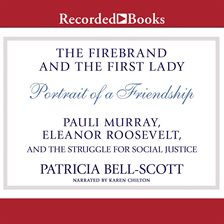Format:
eAudiobook
Electronic Format:
HOOPLA AUDIO BOOK
Format:
eBook
Electronic Format:
HTML, ADOBE EPUB, KINDLE
View Other Search Results
Language
English
Regular print
Summary
Pauli Murray first saw Eleanor Roosevelt in 1933, at the height of the Depression, at a government-sponsored, two-hundred-acre camp for unemployed women where Murray was living, something the first lady had pushed her husband to set up in her effort to do what she could for working women and the poor. The first lady appeared one day unannounced, behind the wheel of her car, her secretary and a Secret Service agent her passengers. To Murray, then aged twenty-three, Roosevelt's self-assurance was a symbol of women's independence, a symbol that endured throughout Murray's life. Five years later, Pauli Murray, a twenty-eight-year-old aspiring writer, wrote a letter to Franklin and Eleanor Roosevelt protesting racial segregation in the South. The president's staff forwarded Murray's letter to the federal Office of Education. The first lady wrote back. Murray's letter was prompted by a speech the president had given at the University of North Carolina, Chapel Hill, praising the school for it
Limit Search Results





